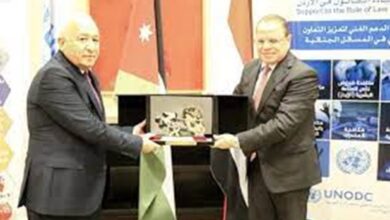In his essay on software engineering methods, Eric Raymond writes about the Cathedral versus the Bazaar model; the former being a process where software code is not disclosed while the latter is a model where code is developed online in the public domain.
In the same spirit, Creative Commons, a non-profit corporation, provides free licenses as legal tools to authors who are interested in sharing their work outside the realm of protectionist intellectual property regimes. One of the major functions of the corporation is to work on adapting these licenses to different domestic laws.
This adaptation has borne fruit in Egypt, as the first draft of the translated Creative Commons license was released for public consultation last week. The adaptation process, spearheaded by the Library of Alexandria in collaboration with Creative Commons, intends to bring about a new era of access to knowledge by breaking traditional monopolies and by re-introducing the concept of sharing.
A dialogue about intellectual property started in Bibliotheca Alexandrina in 2005 where the concept of Creative Commons was introduced. “One year later, the first Access to Knowledge (A2K) meeting was held in Bibliotheca Alexandrina where awareness was raised around the issues of Open Source [Software] and Creative Commons. They were tackled as alternatives that are not against the legal intellectual property system, and yet they are not currently there [within the system]," says Attorney Hala Essalmawi, IPR officer at the library. Essalmawi has been working with a team of lawyers, judges, researchers and IP engineers since 2007 on translating the Creative Commons license and adapting it to Egyptian law.
“The main challenge we encountered was the lack of awareness and understanding of the philosophy behind Creative Commons. Intellectual property was only concerned with restrictions and protection. But there was no dimension of access to knowledge and dissemination,” says Essalmawi. “Creative Commons licenses become an incentive to creators to produce more creative work for the benefit of the community.” However, they are a novelty in a context where the financial rights of an author are highly stressed, sometimes more than his/her moral rights.
Creative Commons’ licenses include a variety of arrangements that strike a balance between protection of some authors’ rights and free dissemination of his/her work. A commonly agreed upon right retained by the author is his/her moral right to attribution. Under one of the licenses, an author can release a work and leave it for re-use and further development, even commercially. Sharing creative work can also be done under the condition that the re-used creation carries the same license. A third license type allows for commercial and non-commercial distribution without changing the original work. Another license only allows for non-commercial distribution and development of the work. Non-commercial re-use and development of an original work can also be undertaken provided the new work carries the same license. Finally, the most restrictive license allows for the free use of the work, but does not allow for changes or commercial reuse.
The licenses, originally drafted in the United States, are based on the American legal system. Hence a lot of the translation work in Egypt included a dimension of adaptation to the Egyptian legal system, which stems from the French tradition. “Arab countries have different legal regimes and some inherited the Anglo-Saxon regime while others took up the French regime,” says Rafik Dammak, engineer, Creative Commons advocate and activist in the Tunisian adaptation of the licenses. “For example, the term ‘commons’ doesn’t exist in the French legal code.”
For Creative Commons, the Egyptian adaptation of the licenses is an example of the increasing interest in the region in finding alternative means of knowledge dissemination, outside of protectionist intellectual property regimes. “Right now the Arab region is coming together and showing a lot of great potential starting with the Jordanian license and now the Egyptian one,” says Michelle Thorne, international project manager with the corporation. “There is a momentum around the culture of Creative Commons in the region.” Jordan was the first Arab country to release a full adaptation of the licenses within its domestic law.
But while countries are working on jurisdiction-specific licenses, Creative Commons has also released versions of the licenses that are based on international intellectual property treaties and which are “jurisdiction-agnostic”. Such licenses have been used by Al-Jazeera Creative Commons Repository, which houses hundreds of broadcast quality footage open for legal sharing. Similarly, Al-Masry Al-Youm’s Multimedia uses this generic license to share its videos under the Creative Commons regime.
In the case of the Egyptian licenses, Bibliotheca Alexandrina’s role in the adaptation process demonstrated the need for partnership and support. “I think that the leadership made by Bibliotheca Alexandrina is a good example of scholarly involvement in the process. It is not only a porting process but also one of capacity building and awareness,” says Dammak.
Now that the draft is open for public discussion, Essalmawi sees the next challenge as the promotion of the licenses’ use. “This is still something to be worked on. Young and mid-career researchers need to be encouraged to use Creative Commons. Famous writers can release their works under Creative Commons after many years of protected rights. Public universities need to think of Creative Commons since they are run by public money,” she says, enumerating possible target groups who might be interested in the licenses.
The Library has produced tool kits that judges in court and other parties can utilize to further understand the legal dimensions of Creative Commons. Nonetheless, the process is available for a variety of stakeholders, from scholars and lawyers, to creators, and knowledge enthusiasts in general.




